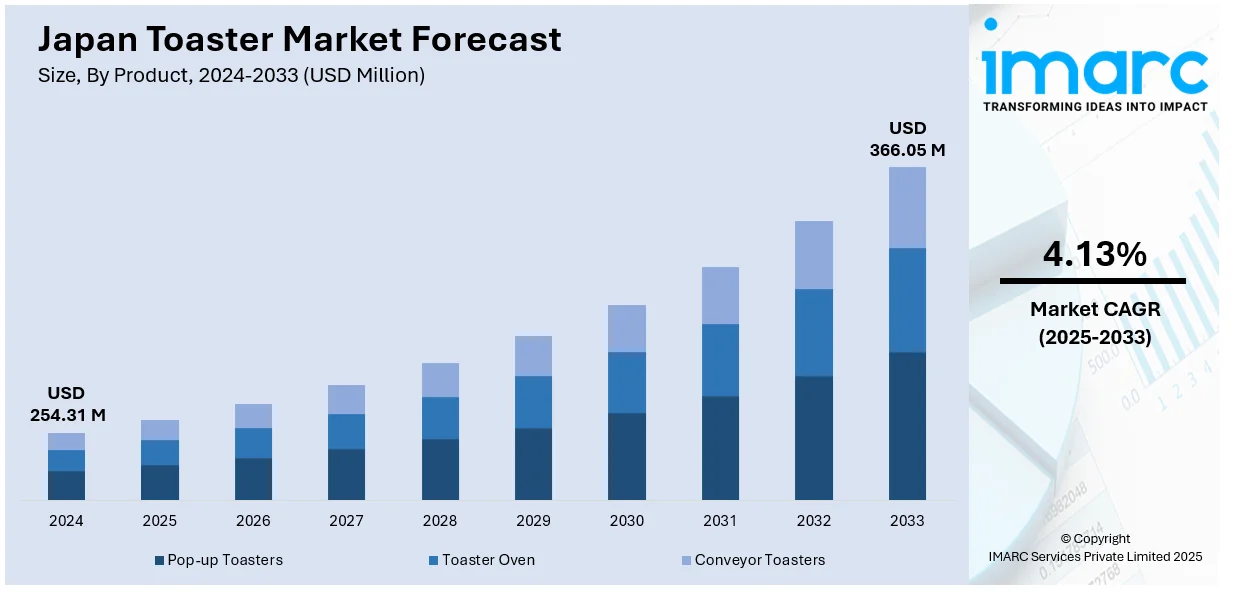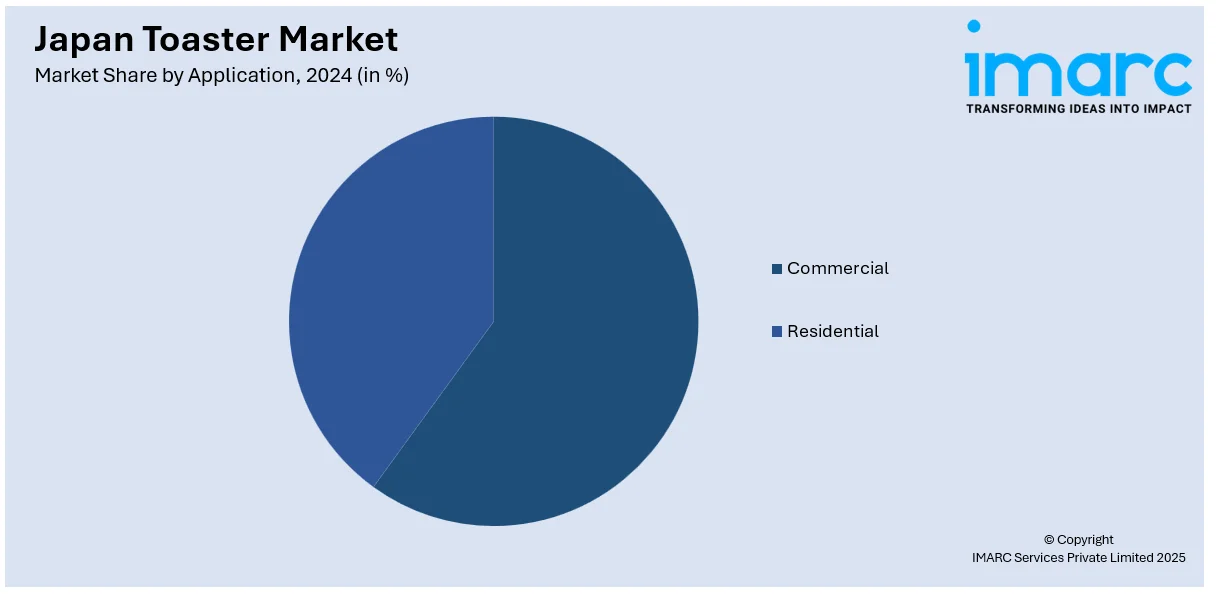
Japan Toaster Market Size, Share, Trends and Forecast by Product, Application, Distribution Channel, and Region, 2025-2033
Japan Toaster Market Overview:
The Japan toaster market size reached USD 254.31 Million in 2024. Looking forward, IMARC Group expects the market to reach USD 366.05 Million by 2033, exhibiting a growth rate (CAGR) of 4.13% during 2025-2033. The market is fueled by evolving consumer lifestyles, demand for compact and multifunctional appliances, and increasing interest in home cooking. Innovations in smart kitchen devices, energy-efficient models, and aesthetic designs are attracting tech-savvy and health-conscious consumers. Online and specialty retail channels further support product accessibility, contributing to Japan toaster market share expansion.
|
Report Attribute
|
Key Statistics
|
|---|---|
|
Base Year
|
2024
|
|
Forecast Years
|
2025-2033
|
|
Historical Years
|
2019-2024
|
| Market Size in 2024 | USD 254.31 Million |
| Market Forecast in 2033 | USD 366.05 Million |
| Market Growth Rate 2025-2033 | 4.13% |
Japan Toaster Market Trends:
Changing Breakfast Habits and Urban Lifestyle
Japan's toaster market is significantly driven by the shift in consumer breakfast preferences and increasingly urbanized lifestyles. Traditionally, Japanese diets focused on rice and soup for breakfast, but there is now a growing inclination toward Western-style meals like toast, sandwiches, and baked goods. The acceleration of urban living, coupled with hectic work schedules, has increased demand for appliances that offer convenience and speed. Small household sizes and compact kitchens further fuel the need for space-saving appliances such as toasters. Additionally, busy professionals and dual-income households prefer appliances that support quick meal preparation, driving toaster sales. This evolving lifestyle dynamic has made toasters an essential kitchen appliance in Japan, contributing substantially to the market’s sustained growth.

Technological Innovation and Design Preferences
Japan’s focus on technological precision and minimalist aesthetics heavily influences the Japan toaster market growth. Consumers favor advanced appliances featuring precise temperature controls, diverse toasting modes, and user-friendly digital interfaces. Manufacturers are integrating smart features, allowing users to control toasting settings via mobile apps, enhancing customization and convenience. Additionally, safety innovations such as cool-touch exteriors, auto shut-off, and crumb collection features are highly valued. Aesthetic preferences also drive the demand for sleek, space-saving, and visually appealing designs that match modern Japanese kitchens. This convergence of functionality, technology, and style is making toasters not only an essential appliance but also a fashionable addition to households, supporting increased adoption and stimulating market competition across both premium and mass-market segments.
Rising Health and Wellness Awareness
Health and wellness consciousness among Japanese consumers is shaping toaster preferences, driving demand for appliances that support healthier eating. Consumers increasingly seek toasters with specialized settings for whole-grain, multigrain, or gluten-free bread, as well as options for oil-free toasting. This trend aligns with broader health awareness campaigns and dietary shifts encouraging balanced and nutritious diets. Additionally, the ability to prepare fresh, homemade meals quickly using toasters with multiple functionalities appeals to consumers aiming to control ingredients and food quality. This alignment of toasters with healthy eating habits reinforces their importance in Japanese households, pushing manufacturers to innovate models that promote wellness without compromising on speed, taste, or convenience, thus supporting the market’s upward trajectory.
Japan Toaster Market Segmentation:
IMARC Group provides an analysis of the key trends in each segment of the market, along with forecasts at the country and regional levels for 2025-2033. Our report has categorized the market based on product, application, and distribution channel.
Product Insights:
- Pop-up Toasters
- Toaster Oven
- Conveyor Toasters
The report has provided a detailed breakup and analysis of the market based on the product. This includes pop-up toasters, toaster oven, and conveyor toasters.
Application Insights:

- Commercial
- Residential
A detailed breakup and analysis of the market based on the application have also been provided in the report. This includes commercial and residential.
Distribution Channel Insights:
- Offline
- Online
A detailed breakup and analysis of the market based on the distribution channel have also been provided in the report. This includes offline and online.
Regional Insights:
- Kanto Region
- Kansai/Kinki Region
- Central/ Chubu Region
- Kyushu-Okinawa Region
- Tohoku Region
- Chugoku Region
- Hokkaido Region
- Shikoku Region
The report has also provided a comprehensive analysis of all the major regional markets, which include the Kanto Region, Kansai/Kinki Region, Central/ Chubu Region, Kyushu-Okinawa Region, Tohoku Region, Chugoku Region, Hokkaido Region, and Shikoku Region.
Competitive Landscape:
The market research report has also provided a comprehensive analysis of the competitive landscape. Competitive analysis such as market structure, key player positioning, top winning strategies, competitive dashboard, and company evaluation quadrant has been covered in the report. Also, detailed profiles of all major companies have been provided.
Japan Toaster Market Report Coverage:
| Report Features | Details |
|---|---|
| Base Year of the Analysis | 2024 |
| Historical Period | 2019-2024 |
| Forecast Period | 2025-2033 |
| Units | Million USD |
| Scope of the Report |
Exploration of Historical Trends and Market Outlook, Industry Catalysts and Challenges, Segment-Wise Historical and Future Market Assessment:
|
| Products Covered | Pop-up Toasters, Toaster Oven, Conveyor Toasters |
| Applications Covered | Commercial, Residential |
| Distribution Channels Covered | Offline, Online |
| Regions Covered | Kanto Region, Kansai/Kinki Region, Central/ Chubu Region, Kyushu-Okinawa Region, Tohoku Region, Chugoku Region, Hokkaido Region, Shikoku Region |
| Customization Scope | 10% Free Customization |
| Post-Sale Analyst Support | 10-12 Weeks |
| Delivery Format | PDF and Excel through Email (We can also provide the editable version of the report in PPT/Word format on special request) |
Key Questions Answered in This Report:
- How has the Japan toaster market performed so far and how will it perform in the coming years?
- What is the breakup of the Japan toaster market on the basis of product?
- What is the breakup of the Japan toaster market on the basis of application?
- What is the breakup of the Japan toaster market on the basis of distribution channel?
- What is the breakup of the Japan toaster market on the basis of region?
- What are the various stages in the value chain of the Japan toaster market?
- What are the key driving factors and challenges in the Japan toaster?
- What is the structure of the Japan toaster market and who are the key players?
- What is the degree of competition in the Japan toaster market?
Key Benefits for Stakeholders:
- IMARC’s industry report offers a comprehensive quantitative analysis of various market segments, historical and current market trends, market forecasts, and dynamics of the Japan toaster market from 2019-2033.
- The research report provides the latest information on the market drivers, challenges, and opportunities in the Japan toaster market.
- Porter's five forces analysis assist stakeholders in assessing the impact of new entrants, competitive rivalry, supplier power, buyer power, and the threat of substitution. It helps stakeholders to analyze the level of competition within the Japan toaster industry and its attractiveness.
- Competitive landscape allows stakeholders to understand their competitive environment and provides an insight into the current positions of key players in the market.
Need more help?
- Speak to our experienced analysts for insights on the current market scenarios.
- Include additional segments and countries to customize the report as per your requirement.
- Gain an unparalleled competitive advantage in your domain by understanding how to utilize the report and positively impacting your operations and revenue.
- For further assistance, please connect with our analysts.
 Request Customization
Request Customization
 Speak to an Analyst
Speak to an Analyst
 Request Brochure
Request Brochure
 Inquire Before Buying
Inquire Before Buying




.webp)




.webp)












